
A bus is a road vehicle that carries significantly more passengers than an average car or van. It is most commonly used in public transport, but is also in use for charter purposes, or through private ownership. Although the average bus carries between 30 and 100 passengers, some buses have a capacity of up to 300 passengers. The most common type is the single-deck rigid bus, with double-decker and articulated buses carrying larger loads, and midibuses and minibuses carrying smaller loads. Coaches are used for longer-distance services. Many types of buses, such as city transit buses and inter-city coaches, charge a fare. Other types, such as elementary or secondary school buses or shuttle buses within a post-secondary education campus, are free. In many jurisdictions, bus drivers require a special large vehicle licence above and beyond a regular driving licence.

Hong Kong has a highly developed and sophisticated transport network, encompassing both public and private transport. Based on Hong Kong Government's Travel Characteristics Survey, over 90% of daily journeys are on public transport, the highest rate in the world. However, in 2014 the Transport Advisory Committee, which advises the Government on transportation issues, issued a report on the much-worsened congestion problem in Hong Kong and pointed at the excessive growth of private cars during the past 10–15 years.

The Toronto Transit Commission (TTC) is the public transport agency that operates bus, subway, streetcar, and paratransit services in Toronto, Ontario, Canada, some of which run into the Peel Region and York Region. It is the oldest and largest of the urban transit service providers in the Greater Toronto Area, with numerous connections to systems serving its surrounding municipalities.

GO Transit is a regional public transit system serving the Greater Golden Horseshoe region of Ontario, Canada. With its hub at Union Station in Toronto, GO Transit's green-and-white trains and buses serve a population of more than seven million across an area over 11,000 square kilometres (4,200 sq mi) stretching from London in the west to Peterborough in the east, and from Barrie in the north to Niagara Falls in the south. In 2022, the system had a ridership of 35,234,400. GO Transit operates diesel-powered double-decker trains and coach buses, on routes that connect with all local and some long-distance inter-city transit services in its service area.

York Region Transit (YRT) is the public transit operator in York Region, Ontario, Canada. Its headquarters are in Richmond Hill, at 50 High Tech Road.
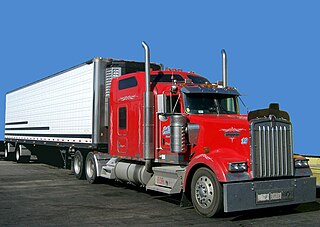
A commercial driver's license (CDL) is a driver's license required in the United States to operate large and heavy vehicles or a vehicle of any size that transports hazardous materials or more than 15 passengers.

MiWay, also known as Mississauga Transit and originally as Mississauga Transit Systems, is the municipal public transport agency serving Mississauga, Ontario, Canada, and is responsible to the city's Transportation and Works Department. MiWay services consist of two types of bus routes: MiLocal, local buses that make frequent stops, and MiExpress, express buses between major destinations. MiWay is the primary operator along the Mississauga Transitway, a dedicated east–west bus-only roadway.

Intermodal passenger transport, also called mixed-mode commuting, involves using two or more modes of transportation in a journey. Mixed-mode commuting is often used to combine the strengths of various transportation options. A major goal of modern intermodal passenger transport is to reduce dependence on the automobile as the major mode of ground transportation and increase use of public transport. To assist the traveller, various intermodal journey planners such as Rome2rio and Google Transit have been devised to help travellers plan and schedule their journey.
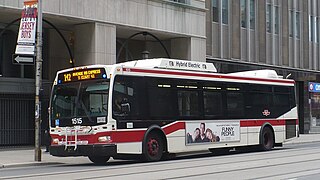
The Toronto Transit Commission (TTC) uses buses and other vehicles for public transportation. In 2018, the TTC bus system had 159 bus routes carrying over 264 million riders over 6,686 kilometres (4,154 mi) of routes with buses travelling 143 millionkilometres in the year. As of 2021, the TTC has 192 bus routes in operation, including 28 night bus routes. In 2022, the system had a ridership of 279,650,000, or about 1,064,700 per weekday as of the first quarter of 2023.

The G series was the first rolling stock of rapid transit cars used on the Toronto subway, built 1953–1959 by the Gloucester Railway Carriage and Wagon Company of Gloucester, England, for the Toronto Transit Commission (TTC) of Toronto, Canada.

The Canadian Light Rail Vehicle (CLRV) and Articulated Light Rail Vehicle (ALRV) were types of streetcars used by the Toronto Transit Commission (TTC) from the late 1970s until the late 2010s. They were built following the TTC's decision to retain streetcar services in the 1970s, replacing the existing PCC streetcar fleet.

A bus driver, bus operator, or bus captain is a person who drives buses for a living.
Accessibility for people with disabilities on the Toronto Transit Commission (TTC) system is incomplete but improving. Most of the Toronto subway system was built before wheelchair access was a requirement under the Ontarians with Disabilities Act (ODA). However, all subway stations built since 1996 are equipped with elevators, and elevators have been installed in 44 stations built before 1996. Over seventy percent of Toronto's subway stations are accessible. All subway stations will be made accessible by 2025.
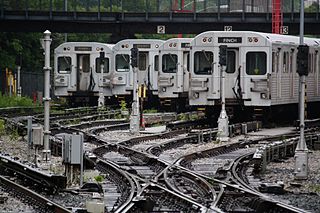
The Toronto subway system's rolling stock consists of 880 subway cars for Line 1 Yonge–University, Line 2 Bloor–Danforth, and Line 4 Sheppard and 28 intermediate-capacity rapid transit cars for Line 3 Scarborough. The rolling stock is owned and maintained by the Toronto Transit Commission (TTC).
The city of Markham in Ontario, Canada, offers a complex transportation infrastructure. These include airports, highways, public transit, regional roads, municipality-funded roads, and train services.

The Toronto Rocket (TR) is the fifth and latest series of rolling stock used in the Toronto subway system in Toronto, Ontario, Canada. Owned and operated by the Toronto Transit Commission (TTC), the trains were built by Bombardier Transportation in Thunder Bay, Ontario, to replace the last remaining H-series trains, as well as increase capacity for the Spadina subway extension to Vaughan that opened in 2017. They operate in a six-car configuration on Line 1 Yonge–University and a four-car configuration on Line 4 Sheppard. The sets are stored and maintained at the Wilson and Davisville Yards. The first six-car TR train entered passenger service on Line 1 in July 2011, and four-car TR trainsets entered service on Line 4 in May 2016.

Public transport bus services are generally based on regular operation of transit buses along a route calling at agreed bus stops according to a published public transport timetable. The state of Tamil Nadu in India operates the world's largest bus corporation called as TNSTC which is fully owned by Government of Tamil nadu, with a fleet of 20,258 buses and a daily ridership of 17 million.

The public light bus (PLB) or minibus is a public transport service in Hong Kong. It uses minibuses to provide quicker transport and to serve areas that standard Hong Kong bus lines cannot reach as efficiently. The vehicles are colloquially known by the code-switch Van仔 literally "van-ette".
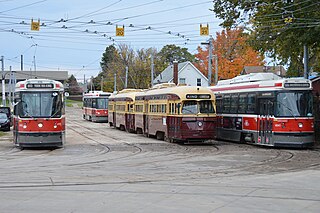
In 1921, the Toronto Transportation Commission (TTC) was created to integrate and operate the Toronto streetcar system. It inherited the infrastructure of two separate streetcar operators: the Toronto Railway Company (TRC) and Toronto Civic Railways (TCR). The TTC immediately embarked on a program to connect the TRC and TCR lines into one network. The TTC had to rebuild most of the track to provide a wider devilstrip so that the wider Peter Witt streetcars it was ordering could pass without sideswiping. Between 1938 and 1945, it placed five orders for air-electric PCC streetcars to replace the old, wooden streetcars of the TRC, and to address rising ridership. Between 1947 and 1951, the TTC placed three orders for all-electric PCC cars, with one order equipped with couplers for multiple-unit operation. Between 1950 and 1957, the TTC purchased PCCs from four American cities. By 1957, the TTC had more PCCs than any other city in North America. After the opening of the Bloor–Danforth subway in 1966, the TTC considered terminating all streetcar service in Toronto. However, in 1972, a citizens group led by Jane Jacobs and Steve Munro called "Streetcars for Toronto" persuaded the City to retain streetcar operation. This led to the development of the Canadian Light Rail Vehicle (CLRV) and its longer, articulated cousin, the Articulated Light Rail Vehicle (ALRV), to replace the aging PCC fleet. The Accessibility for Ontarians with Disabilities Act, 2005 (AODA) mandated that the next generation of streetcars be wheelchair-accessible. Thus, to replace the CLRVs and ALRVs, Bombardier adapted its low-floor Flexity Outlook model for the TTC to navigate the Toronto streetcar system's tight curves and single-point switches, characteristics set in the 1920s to accommodate Peter Witt streetcars.
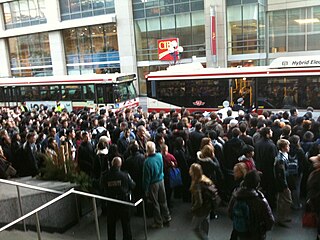
This article lists major incidents of the Toronto Transit Commission (TTC) since 1954, such as accidents and other notable unplanned events.





















